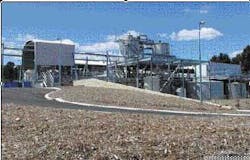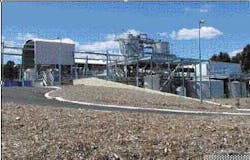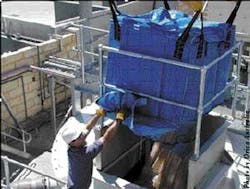MIEX® process reduces dissolved organic oxygen in groundwater
By Chris Botica, Raymond Lange, Paul Smith, John Tattersall
The world's first large-scale MIEX® water treatment, located at the Wanneroo groundwater treatment plant in Australia, successfully passed performance testing last March 2002 and is now operating. The Water Corporation of Western Australia initiated the design and construction of the plant in July 2000.
The water source at Wanneroo contains high levels of dissolved organic carbon (DOC), which are linked to the formation of Dimethyl Trisulphide (DMTS). MIEX treatment, coupled with the existing conventional treatment plant, will substantially reduce DOC.
Intermittent outbreaks of DMTS in the water distribution system led the utility to research various water treatment technologies to remove dissolved organic carbon. The presence of DMTS in tap water is noted as a "swampy" odour, and is suspected to be the product of biological action in the distribution system. DOC in treated water promotes biofilm growth in the distribution system and this, coupled with non-sulphide-reduced-sulphur in the water, leads to DMTS formation.
The utility operated a one million litre per day MIEX pilot plant at the Wanneroo treatment plant in addition to conducting laboratory tests over a two-year period. Technicians tested winter and summer bore combinations to generate process performance data for all likely operating scenarios. Removal figures shows that a 60% reduction in raw water DOC could be achieved prior to alum coagulation, which further reduced the DOC concentration from around 12 mg/l to approximately 1.5 to 2.0 mg/l.
The Water Corporation of Western Australia appointed Black & Veatch Australia as the engineering, procurement and construction (EPC) contractor to deliver the MIEX plant at the Wanneroo plant, which cost Aus$ 15 million. The full-scale treatment train has a capacity of 112.5 mld. The design facilitates incorporation of a second train of the same capacity. Fifty boreholes supply raw water to the Wanneroo water treatment plant, which has a peak capacity of 225 mld.
The MIEX process differs from conventional ion exchange technology in that the ion exchange step is carried out on a continuous basis, while the regeneration step is performed in a batch operation. This allows steady state conditions to be maintained in the ion exchange stage of the process. The resin particles are also smaller (150 um) than conventional ion exchange resins. Following contact with the raw water, a magnetic component within the resin matrix allows particles to form larger agglomerates that settle out at a high rate (25 m3/hr).
Orica Australia, a chemical manufacturer based in Melbourne, Australia, and the Commonwealth Scientific Industrial Research Organisation (CSIRO) Molecular Science Department developed the MIEX resin. The water utility, SA Water Corporation, based in Adelaide, and Orica developed the MIEX process technology; however the Water Corporation of Western Australia further developed the process for large-scale application.
Plant process design
The Wanneroo MIEX plant consists of two 400 m3 concrete contactors in which the MIEX resin and raw water are mixed thoroughly. The design contact time is ten minutes at full flow conditions. The resin concentration in the contactors may be varied to suit raw water quality and plant flow at any time.
The resin/raw water mix flows from the contactors to six concrete hopper-bottomed settlers. The Fitch-type feedwells inside the settlers encourage inter-particle contact while decreasing the velocity head of the inlet stream. The gentle flow conditions inside the feedwells allow the magnetic forces of attraction between the resin particles to take effect, resulting in larger agglomerates of resin to form and settle out into the hopper bottoms. The feedwell depth extends to the point in the settlers where the hopper-bottom section begins, maximising the opportunity for resin coagulation and settlement. The maximum rise rate in the settlers of 15 m3/h allows over 99.9% recovery of the resin. The settler overflow of MIEX-treated water then rejoins the conventional process stream upstream of the plant clarifiers. The resin slurry is collected at the base of the settlers and pumped back to the head of the process to either return to the first contactor or be taken off for regeneration.
A percentage (5% to 10%) of the resin slurry is removed from the recycle stream and diverted to the regeneration facility. Resin regeneration is accomplished using a 12% brine solution (the regenerant). Although the regenerant increases in DOC and sulphate concentration with each step, the regenerant can be used for multiple regenerations. It has been reused up to nine times on pilot plant trials while laboratory data supports the possibility of up to 12 reuses. Each reuse cycle requires an adjustment of the regenerant, returning the chloride concentration to the original starting point prior to the next cycle.
Once regenerated, the resin is transferred from the regeneration vessel into the fresh resin tank, from where it rejoins the MIEX process in the first contactor. The rate at which the fresh resin is delivered to the process matches that of the resin that is removed from the stream for regeneration. This maintains a constant resin concentration in the two contactors.
The brine solution is prepared in two storage-type salt saturators as used in the chlor-alkali industry. A "clean" saturator provides the regeneration facility with a fresh charge of brine for the first regeneration. The second, a "dirty" saturator, is used to saturate a portion of the used regenerant with brine for nine reuse cycles.
Process performance
Pilot trials and laboratory work provided conclusive results indicating that the MIEX process and alum coagulation or other chemical coagulation complement each other, regardless of process order. For the raw water at Wanneroo, the MIEX process favours removal of the lower molecular weight fraction of DOC, while alum coagulation removes the larger molecular weight DOC components. This results in impressive reductions of DOC through the plant. A final DOC of less than 2 mg/l is achieved by combining MIEX treatment and enhanced coagulation, assuming an incoming raw water DOC of 9.5 mg/l.
Removing the smaller DOC fractions prior to coagulation enables more efficient use of the coagulant. Jar tests show that MIEX-treated water, with a coagulant dose of one-half of the conventional dose, can produce higher water quality in terms of DOC than conventionally treated water. The lower coagulant dose also creates less of a pH depression, placing less demand on pH correction after coagulation. The treatment process downstream of MIEX treatment will therefore operate using reduced chemical dose rates, and produce less sludge. These process advantages will be achieved at the Wanneroo groundwater treatment plant by constructing the MIEX plant at the head of the treatment stream.
Resin loss
The 99.9% recovery figure is based on the resin mass leaving the MIEX process in the treated water stream. The indicated 0.1% loss rate is in the form of attrited resin, which can no longer attach itself to the bulk of the resin particles in the settler feed. These smaller resin particles escape the process with the treated water discharged from the settler overflow. A certain degree of resin attrition is unavoidable due to resin transport/pumping and mixing in the process units. The use of low shear mixers and low shear pumps minimises resin loss.
Conclusion
More stringent water quality requirements being implemented worldwide provide strong incentives to utilities to use a range of new technologies developed to meet these new challenges. MIEX water treatment can result in substantial DOC reduction while using a lower coagulant dose when coupled with an existing conventional treatment plant. It produces a more stable water, in terms of chlorine demand, and reduces operating costs by using a lower overall chlorine dose. The MIEX treated water also contains reduced levels of disinfection by-products, such as trihalomethanes (THM), which is a significant step in improving water quality.
Authors' note
Project Engineer Raymond Lange of Black and Veatch Australia is located in Perth. Engineering Manager John Tattersall of Paterson Candy, a wholly-owned subsidiary of Black and Veatch, is located in London, England. Project Engineer Chris Botica and Paul Smith, a process engineer, work with the Water Corporation of Western Australia, based in Perth, Australia.



